Synergistic Control of Shrinkage and Mechanical Properties in Expansive Soil Slurry via Coupled Cement–Fiber Reinforcement
Abstract
1. Introduction
2. Materials and Methods
2.1. Raw Materials
2.2. Sample Preparation
2.3. Fluidity Test
2.4. Flexural Strength and Compressive Strength
2.5. Drying Shrinkage
2.6. Autogenous Shrinkage
2.7. X-Ray Diffraction (XRD)
2.8. Scanning Electron Microscope (SEM) Test
3. Results and Discussion
3.1. Fluidity of Expansive Slurry
3.2. Strength of Hardened Specimens
3.3. Drying Shrinkage
3.4. Autogenous Shrinkage
3.5. XRD Analysis
3.6. SEM and EDS Analysis
3.7. The Physical–Chemical Coupling Mechanism
4. Conclusions
Author Contributions
Funding
Data Availability Statement
Conflicts of Interest
References
- Baghbani, A.; Choudhury, T.; Costa, S.; Reiner, J. Application of Artificial Intelligence in Geotechnical Engineering: A State-of-the-Art Review. Earth-Sci. Rev. 2022, 228, 103991. [Google Scholar] [CrossRef]
- Basma, A.A.; Al-Homoud, A.S.; Malkawi, A.I.H.; Al-Bashabsheh, M.A. Swelling-Shrinkage Behavior of Natural Expansive Clays. Appl. Clay Sci. 1996, 11, 211–227. [Google Scholar] [CrossRef]
- Alnmr, A.; Ray, R.; Alzawi, M.O. A Novel Approach to Swell Mitigation: Machine-Learning-Powered Optimal Unit Weight and Stress Prediction in Expansive Soils. Appl. Sci. 2024, 14, 1411. [Google Scholar] [CrossRef]
- Luo, P.; Ma, M. Failure Mechanisms and Protection Measures for Expansive Soil Slopes: A Review. Sustainability 2024, 16, 5127. [Google Scholar] [CrossRef]
- Shi, B.; Jiang, H.; Liu, Z.; Fang, H.Y. Engineering Geological Characteristics of Expansive Soils in China. Eng. Geol. 2002, 67, 63–71. [Google Scholar] [CrossRef]
- Dai, Z.; Zhang, C.; Wang, L.; Fu, Y.; Zhang, Y. Interpreting the Influence of Rainfall and Reservoir Water Level on a Large-Scale Expansive Soil Landslide in the Danjiangkou Reservoir Region, China. Eng. Geol. 2021, 288, 106110. [Google Scholar] [CrossRef]
- Lu, Z.; Chen, Z.; Pu, Y. A CT Study on the Crack Evolution of Expansive Soil during Drying and Wetting Cycles. Rock Soil Mech. 2002, 4, 417–422. (In Chinese) [Google Scholar]
- Wang, W.; Kong, L.; Zang, M.; Zhang, C. Experimental Research on Crack Extension and Indoor Rainfall Infiltration of Nanyang Expansive Soil. J. Southwest Pet. Univ. Technol. Ed. 2015, 37, 174–184. (In Chinese) [Google Scholar]
- Petry, T.M.; Little, D.N. Review of Stabilization of Clays and Expansive Soils in Pavements and Lightly Loaded Structures—History, Practice, and Future. J. Mater. Civ. Eng. 2002, 14, 447–460. [Google Scholar] [CrossRef]
- Seco, A.; Ramírez, F.; Miqueleiz, L.; García, B. Stabilization of Expansive Soils for Use in Construction. Appl. Clay Sci. 2011, 51, 348–352. [Google Scholar] [CrossRef]
- Punthutaecha, K.; Puppala, A.J.; Vanapalli, S.K.; Inyang, H. Volume Change Behaviors of Expansive Soils Stabilized with Recycled Ashes and Fibers. J. Mater. Civ. Eng. 2006, 18, 295–306. [Google Scholar] [CrossRef]
- Tiwari, N.; Satyam, N.; Puppala, A.J. Strength and Durability Assessment of Expansive Soil Stabilized with Recycled Ash and Natural Fibers. Transp. Geotech. 2021, 29, 100556. [Google Scholar] [CrossRef]
- Al-Rawas, A.A.; Hago, A.W.; Al-Sarmi, H. Effect of Lime, Cement and Sarooj (Artificial Pozzolan) on the Swelling Potential of an Expansive Soil from Oman. Build. Environ. 2005, 40, 681–687. [Google Scholar] [CrossRef]
- Sharma, A.K.; Sivapullaiah, P.V. Ground Granulated Blast Furnace Slag Amended Fly Ash as an Expansive Soil Stabilizer. Soils Found. 2016, 56, 205–212. [Google Scholar] [CrossRef]
- Barman, D.; Dash, S.K. Stabilization of Expansive Soils Using Chemical Additives: A Review. J. Rock Mech. Geotech. Eng. 2022, 14, 1319–1342. [Google Scholar] [CrossRef]
- Chandru, S.; Jayalekshmi, S. Supplementation of RHA for Enhancing Strength and Durability of Lime-Treated Expansive Soil under Challenging Environmental Conditions. Int. J. Pavement Eng. 2025, 26, 2479067. [Google Scholar] [CrossRef]
- Anggraini, M.; Setiawan, D.M.; Saleh, A. Chemical Stabilization Techniques for Clay Soil: A Comprehensive Review. J. Mech. Behav. Mater. 2025, 34, 20250056. [Google Scholar] [CrossRef]
- Almuaythir, S.; Zaini, M.S.I.; Hasan, M.; Hoque, M.I. Sustainable Soil Stabilization Using Industrial Waste Ash: Enhancing Expansive Clay Properties. Heliyon 2024, 10, e39124. [Google Scholar] [CrossRef] [PubMed]
- Zeng, Q.; Liu, X.; Zhang, Z.; Wei, C.; Xu, C. Synergistic Utilization of Blast Furnace Slag with Other Industrial Solid Wastes in Cement and Concrete Industry: Synergistic Mechanisms, Applications, and Challenges. Green Energy Resour. 2023, 1, 100012. [Google Scholar] [CrossRef]
- Goodarzi, A.R.; Akbari, H.R.; Salimi, M. Enhanced Stabilization of Highly Expansive Clays by Mixing Cement and Silica Fume. Appl. Clay Sci. 2016, 132, 675–684. [Google Scholar] [CrossRef]
- Sharma, L.K.; Sirdesai, N.N.; Sharma, K.M.; Singh, T.N. Experimental Study to Examine the Independent Roles of Lime and Cement on the Stabilization of a Mountain Soil: A Comparative Study. Appl. Clay Sci. 2018, 152, 183–195. [Google Scholar] [CrossRef]
- Mahedi, M.; Cetin, B.; White, D.J. Cement, Lime, and Fly Ashes in Stabilizing Expansive Soils: Performance Evaluation and Comparison. J. Mater. Civ. Eng. 2020, 32, 04020177. [Google Scholar] [CrossRef]
- Sahoo, S.; Singh, S.P. Strength and Durability Properties of Expansive Soil Treated with Geopolymer and Conventional Stabilizers. Constr. Build. Mater. 2022, 328, 127078. [Google Scholar] [CrossRef]
- Khadka, S.D.; Jayawickrama, P.W.; Senadheera, S.; Segvic, B. Stabilization of Highly Expansive Soils Containing Sulfate Using Metakaolin and Fly Ash Based Geopolymer Modified with Lime and Gypsum. Transp. Geotech. 2020, 23, 100327. [Google Scholar] [CrossRef]
- Ding, J.; Ma, D.; Zhang, R.; Jiang, D. Investigating on Dynamic and Static Mechanical Characteristics and Microscopic Mechanism of Fiber-Reinforced and Rubberized Cement Stabilized Soil under Dry-Wet Cycle Sulfate Erosion. Constr. Build. Mater. 2025, 487, 142083. [Google Scholar] [CrossRef]
- Cai, Y.; Shi, B.; Ng, C.W.; Tang, C. Effect of Polypropylene Fibre and Lime Admixture on Engineering Properties of Clayey Soil. Eng. Geol. 2006, 87, 230–240. [Google Scholar] [CrossRef]
- Sharo, A.A.; Alawneh, A.S.; Al Zghool, H.N.; Rabab’ah, S.R. Effect of Alkali-Resistant Glass Fibers and Cement on the Geotechnical Properties of Highly Expansive Soil. J. Mater. Civ. Eng. 2022, 34, 04021417. [Google Scholar] [CrossRef]
- Zhang, H.; Chen, W.; He, B.; Zhu, X.; Jiang, Z. Compressive Behaviour and Microstructure of Geopolymer Mortar Subjected to Cryogenic Freeze-Thaw Cycle: Effects of Cycles and Polypropylene Fiber. Cem. Concr. Compos. 2024, 149, 105505. [Google Scholar] [CrossRef]
- Chaduvula, U.; Viswanadham, B.V.S.; Kodikara, J. A Study on Desiccation Cracking Behavior of Polyester Fiber-Reinforced Expansive Clay. Appl. Clay Sci. 2017, 142, 163–172. [Google Scholar] [CrossRef]
- Tong, F.; Ma, Q.; Xing, W. Improvement of Clayey Soils by Combined Bamboo Strip and Flax Fiber Reinforcement. Adv. Civ. Eng. 2019, 2019, 7274161. [Google Scholar] [CrossRef]
- Hejazi, S.M.; Sheikhzadeh, M.; Abtahi, S.M.; Zadhoush, A. A Simple Review of Soil Reinforcement by Using Natural and Synthetic Fibers. Constr. Build. Mater. 2012, 30, 100–116. [Google Scholar] [CrossRef]
- Gidebo, F.A.; Kinoshita, N.; Yasuhara, H. Optimization of Physical and Strength Performance of Cellulose-Based Fiber Additives Stabilized Expansive Soil. Case Stud. Constr. Mater. 2024, 20, e02851. [Google Scholar] [CrossRef]
- Medina-Martinez, C.J.; Sandoval-Herazo, L.C.; Zamora-Castro, S.A.; Vivar-Ocampo, R.; Reyes-Gonzalez, D. Natural Fibers: An Alternative for the Reinforcement of Expansive Soils. Sustainability 2022, 14, 9275. [Google Scholar] [CrossRef]
- Al-Mahbashi, A.M.; Al-Shamrani, M.A.; Moghal, A.A.B. Soil–Water Characteristic Curve and One-Dimensional Deformation Characteristics of Fiber-Reinforced Lime-Blended Expansive Soil. J. Mater. Civ. Eng. 2020, 32, 04020125. [Google Scholar] [CrossRef]
- Puppala, A.J.; Musenda, C. Effects of Fiber Reinforcement on Strength and Volume Change in Expansive Soils. Transp. Res. Rec. 2000, 1736, 134–140. [Google Scholar] [CrossRef]
- Kim, Y.T.; Kim, H.J.; Lee, G.H. Mechanical Behavior of Lightweight Soil Reinforced with Waste Fishing Net. Geotext. Geomembr. 2008, 26, 512–518. [Google Scholar] [CrossRef]
- Chaduvula, U.; Viswanadham, B.V.S.; Kodikara, J. Centrifuge Model Studies on Desiccation Cracking Behaviour of Fiber-Reinforced Expansive Clay. Geotext. Geomembr. 2022, 50, 480–497. [Google Scholar] [CrossRef]
- Syed, M.; GuhaRay, A. Effect of Natural Fiber Reinforcement on Strength Response of Alkali Activated Binder Treated Expansive Soil: Experimental Investigation and Reliability Analysis. Constr. Build. Mater. 2021, 273, 121743. [Google Scholar] [CrossRef]
- Alila, M.; Aziz, M.; Hamza1c, M.; Madni3d, M.F. Engineering Properties of Expansive Soil Treated with Polypropylene Fibers. Geomech. Eng. 2020, 22, 227–236. [Google Scholar]
- GB/T 175-2023; Common Portland Cement. China Architecture and Building Press: Beijing, China, 2023.
- Zhang, J.; Xu, W.; Gao, P.; Su, L.; Kun, B.; Yueyuan, L.; Bohan, Y. Integrity and Crack Resistance of Hybrid Polypropylene Fiber Reinforced Cemented Soil. J. Eng. Fibers Fabr. 2022, 17, 1–16. [Google Scholar] [CrossRef]
- T/CECS 1175-2022; Technical Specification for Self-compacted Soil Filling in Construction Engineering. China Engineering Construction Standardization Association: Beijing, China, 2023.
- GB/T 17671-2021; Test Method of Cement Mortar Strength (ISO Method). Standards Press of China: Beijing, China, 2021.
- ASTM C 1698-09; Standard Test Method for Autogenous Strain of Cement Paste and Mortar. ASTM: West Conshohocken, PA, USA, 2014.
- Wu, J.; Yuan, J.; Ng, C.W. Theoretical and Experimental Study of Initial Cracking Mechanism of an Expansive Soil Due to Moisture-Change. J. Cent. South Univ. 2012, 19, 1437–1446. [Google Scholar] [CrossRef]
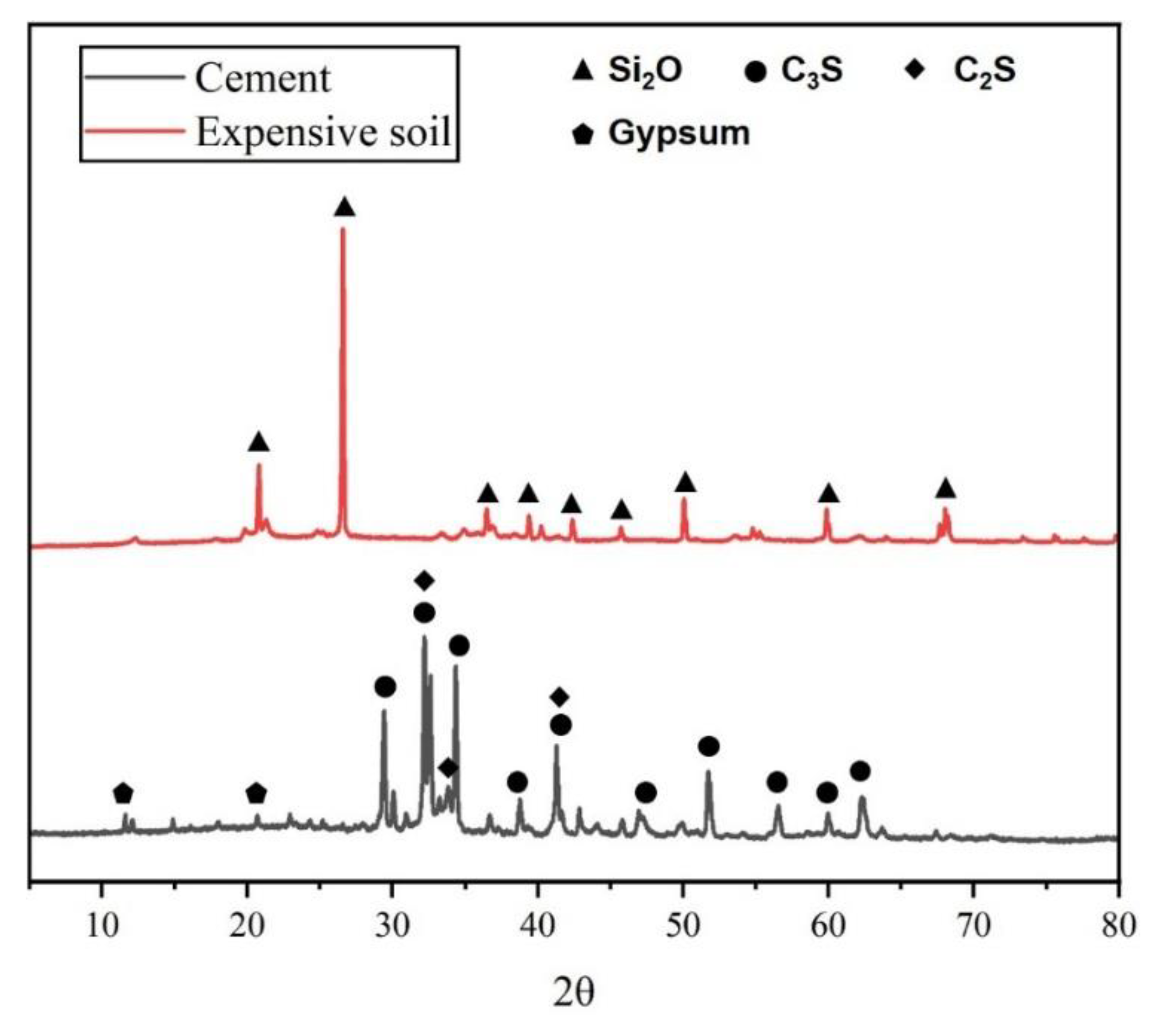


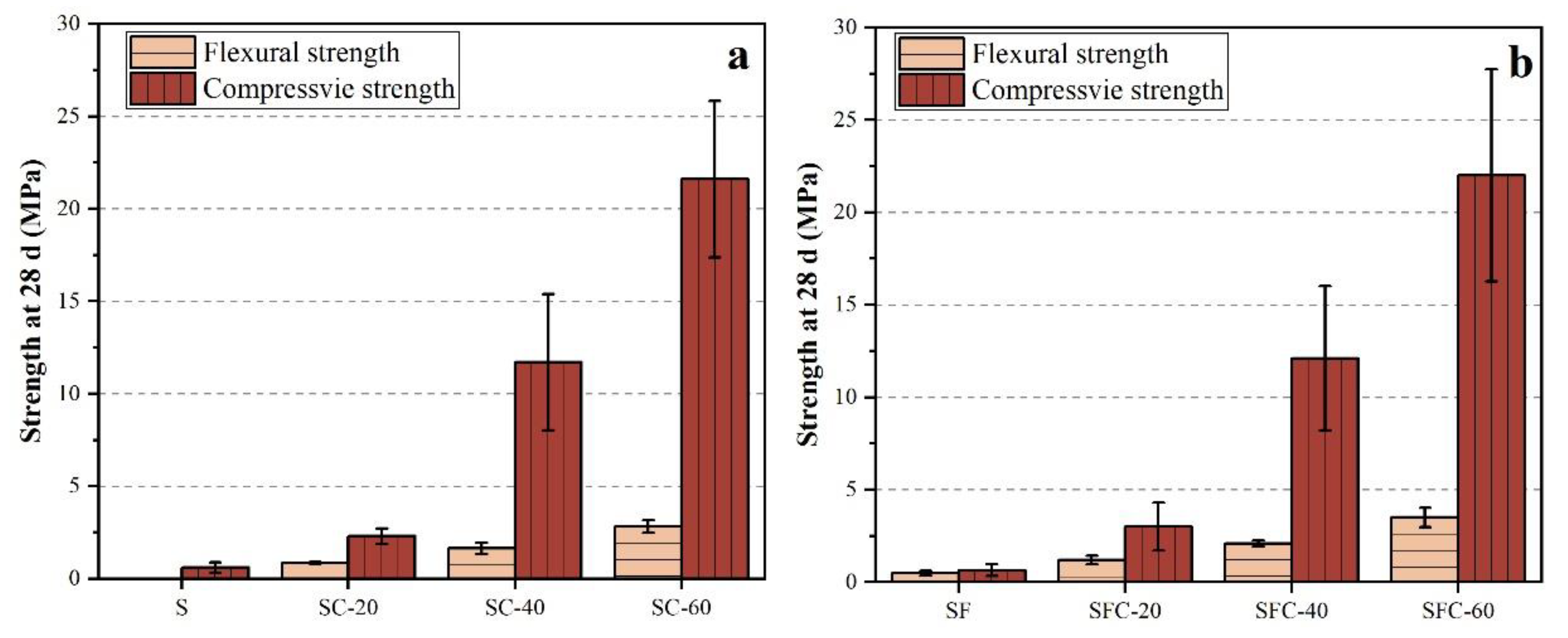
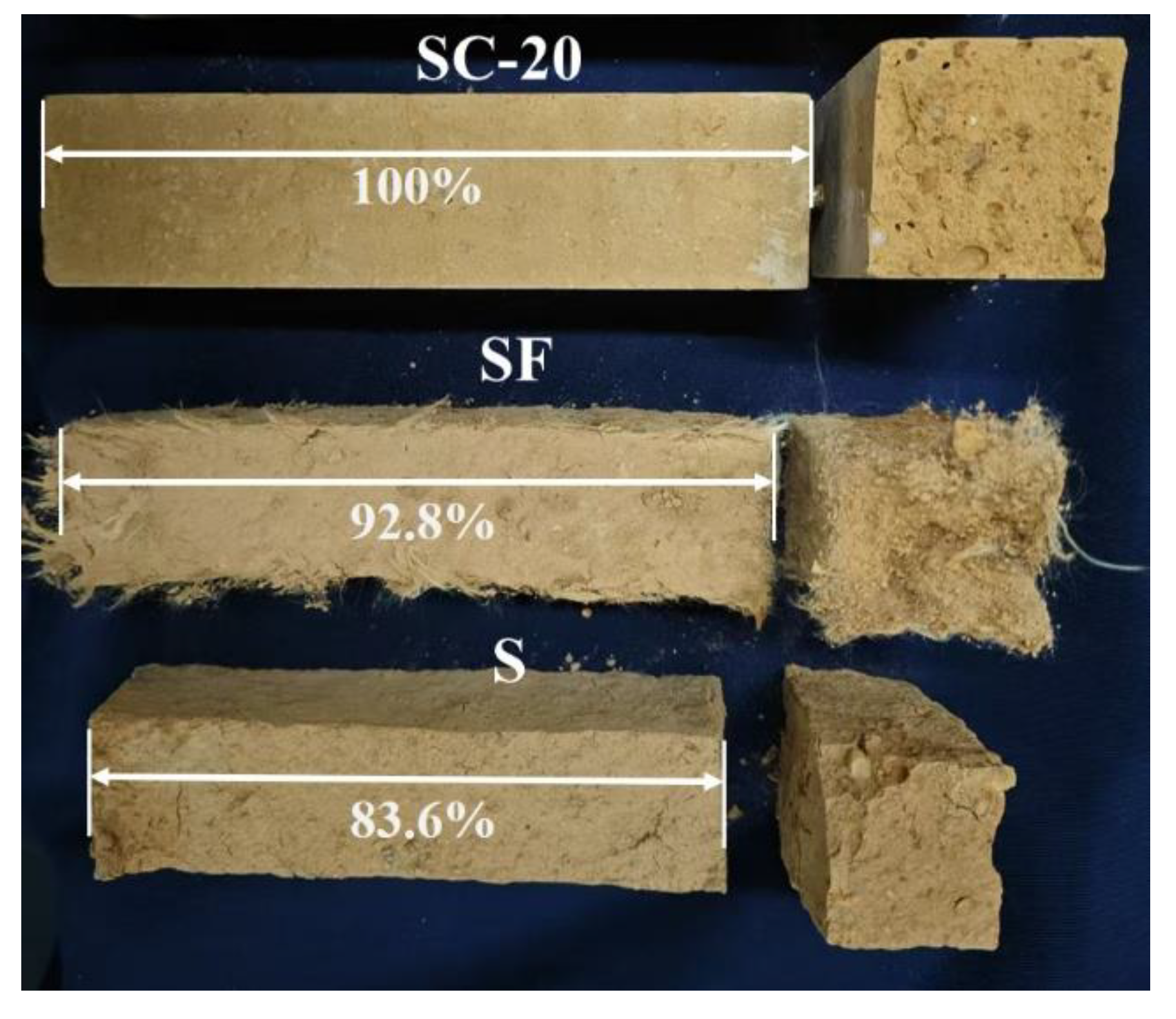


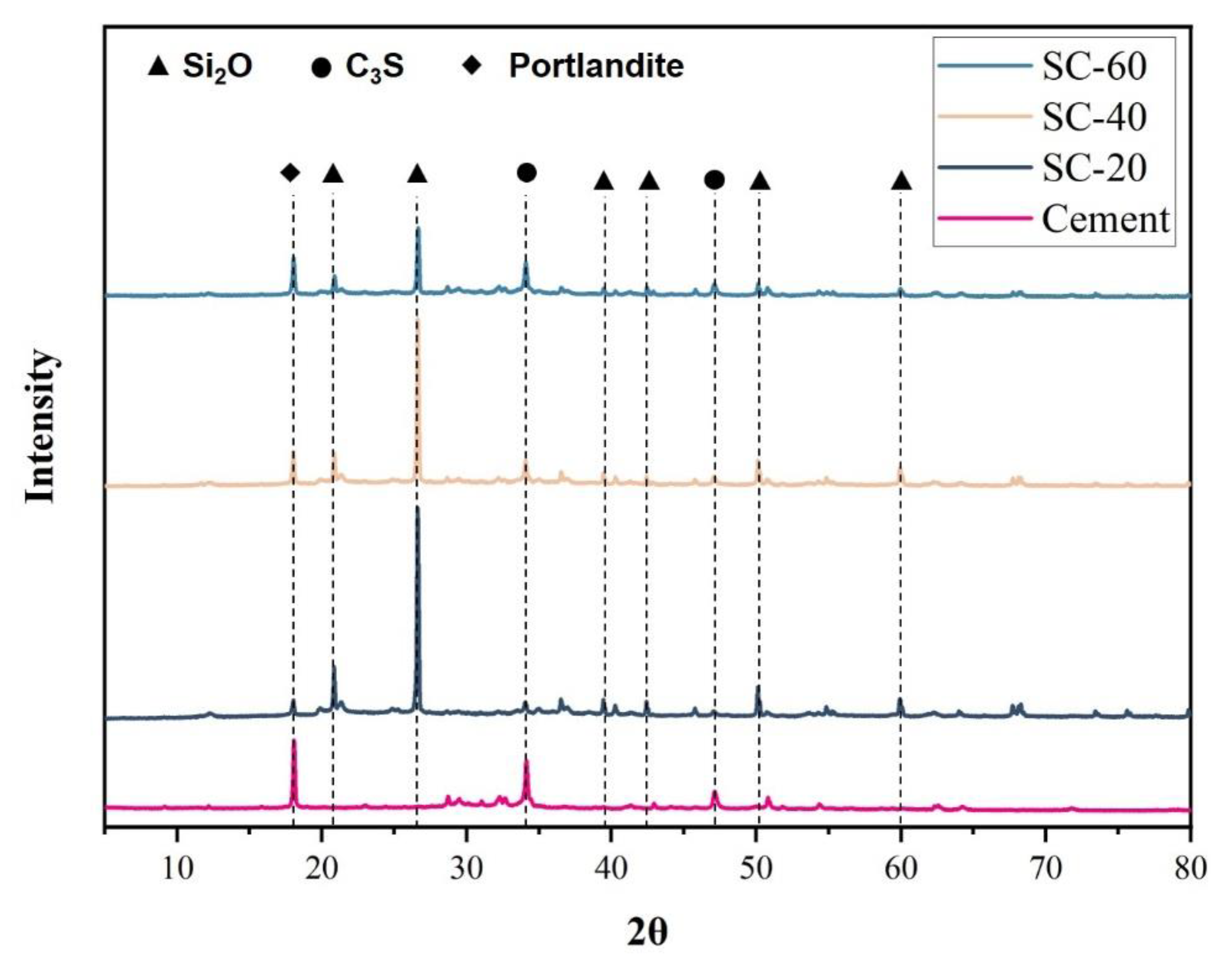
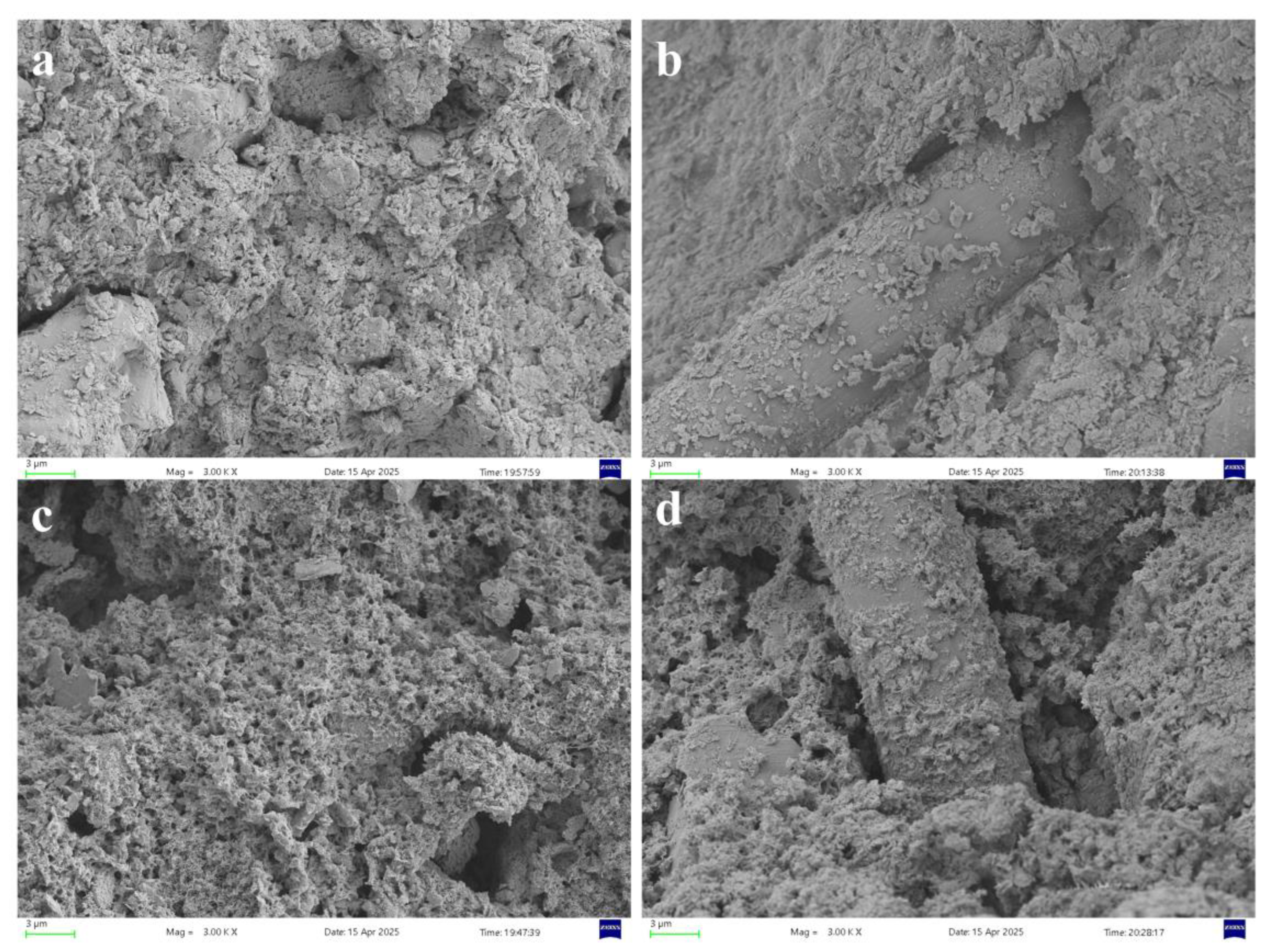
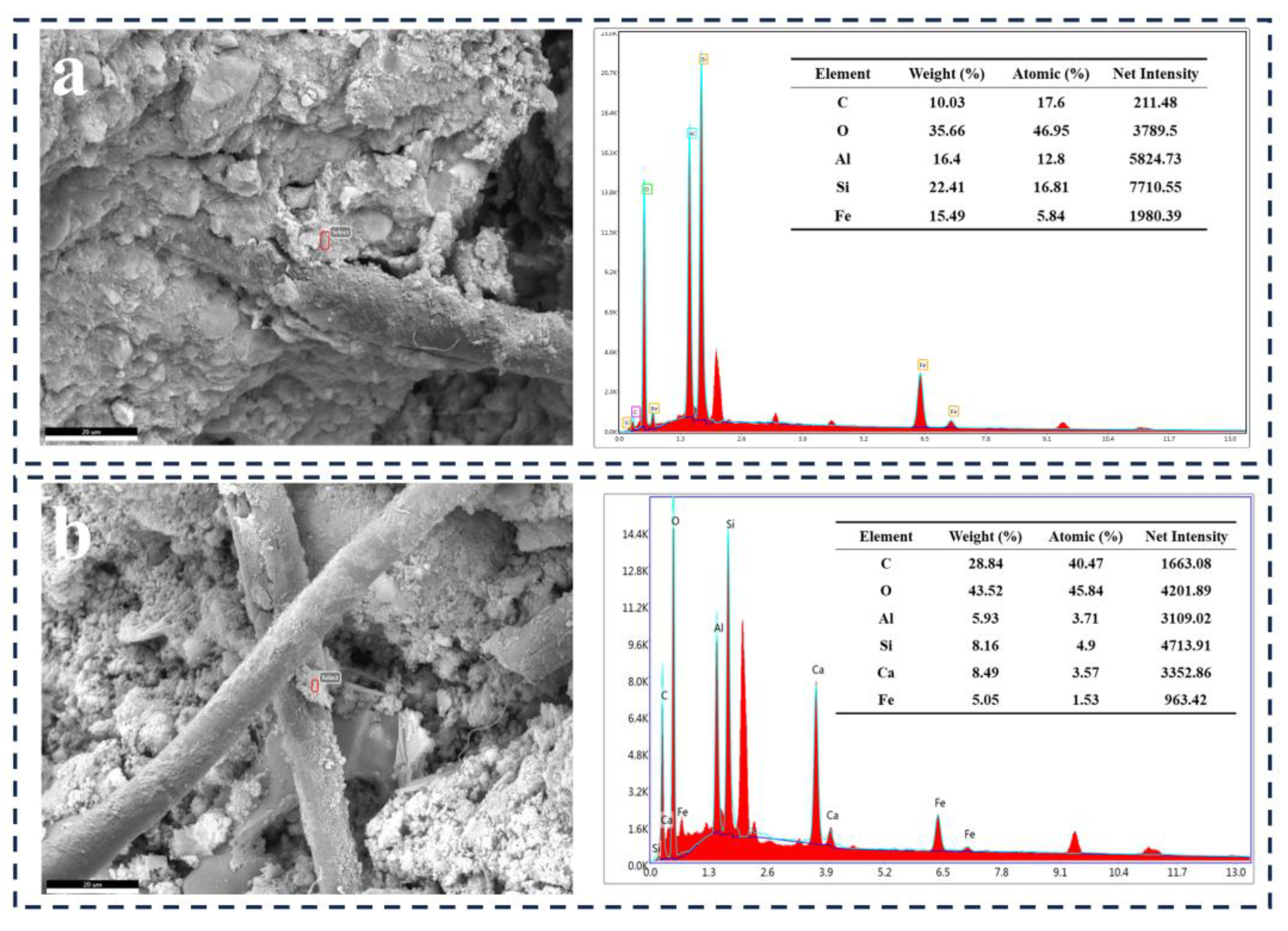
| Raw Material | SiO2 | Al2O3 | Fe2O3 | SO3 | CaO | K2O | ZnO | TiO2 | LOI. |
|---|---|---|---|---|---|---|---|---|---|
| Cement | 19.47 | 3.83 | 4.00 | 2.73 | 68.10 | 1.14 | 0.12 | 0.30 | 0.31 |
| Expansive soil | 59.30 | 22.31 | 15.23 | - | 0.11 | 0.99 | 0.01 | 1.79 | 0.26 |
| Sample | Expansive Soil (g) | Cement (g) | Polypropylene Fibers (g) | Water (g) |
|---|---|---|---|---|
| S | 1470 | 0 | 0 | 450 |
| SC-20 | 1176 | 240 | 0 | 504 |
| SC-40 | 882 | 480 | 0 | 558 |
| SC-60 | 588 | 720 | 0 | 612 |
| SF | 1470 | 0 | 6 | 450 |
| SFC-20 | 1176 | 240 | 6 | 504 |
| SFC-40 | 882 | 480 | 6 | 558 |
| SFC-60 | 588 | 720 | 6 | 612 |
Disclaimer/Publisher’s Note: The statements, opinions and data contained in all publications are solely those of the individual author(s) and contributor(s) and not of MDPI and/or the editor(s). MDPI and/or the editor(s) disclaim responsibility for any injury to people or property resulting from any ideas, methods, instructions or products referred to in the content. |
© 2025 by the authors. Licensee MDPI, Basel, Switzerland. This article is an open access article distributed under the terms and conditions of the Creative Commons Attribution (CC BY) license (https://creativecommons.org/licenses/by/4.0/).
Share and Cite
Zhang, D.; Wang, Y.; Zhang, Z.; Sun, Z.; Wang, C.; Zou, S. Synergistic Control of Shrinkage and Mechanical Properties in Expansive Soil Slurry via Coupled Cement–Fiber Reinforcement. Buildings 2025, 15, 2550. https://doi.org/10.3390/buildings15142550
Zhang D, Wang Y, Zhang Z, Sun Z, Wang C, Zou S. Synergistic Control of Shrinkage and Mechanical Properties in Expansive Soil Slurry via Coupled Cement–Fiber Reinforcement. Buildings. 2025; 15(14):2550. https://doi.org/10.3390/buildings15142550
Chicago/Turabian StyleZhang, Dongxing, Yuchen Wang, Zhaohong Zhang, Zhenping Sun, Chengzhi Wang, and Shuang Zou. 2025. "Synergistic Control of Shrinkage and Mechanical Properties in Expansive Soil Slurry via Coupled Cement–Fiber Reinforcement" Buildings 15, no. 14: 2550. https://doi.org/10.3390/buildings15142550
APA StyleZhang, D., Wang, Y., Zhang, Z., Sun, Z., Wang, C., & Zou, S. (2025). Synergistic Control of Shrinkage and Mechanical Properties in Expansive Soil Slurry via Coupled Cement–Fiber Reinforcement. Buildings, 15(14), 2550. https://doi.org/10.3390/buildings15142550





